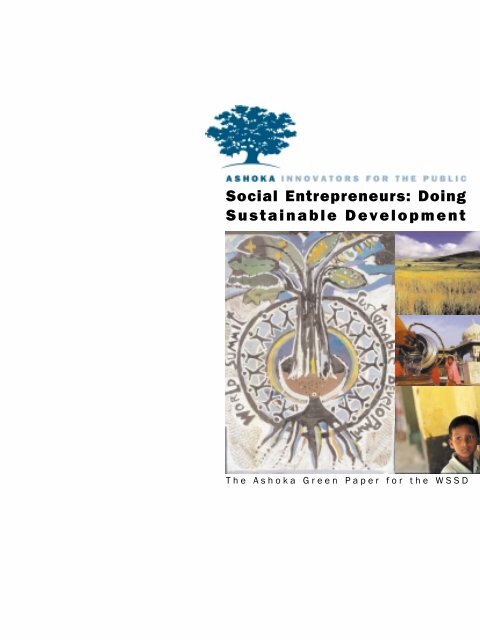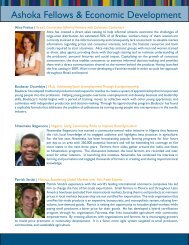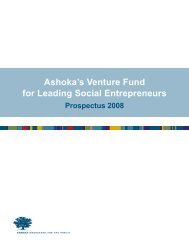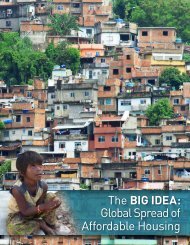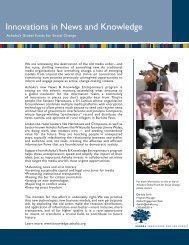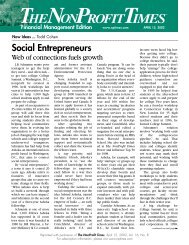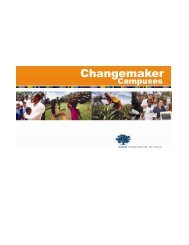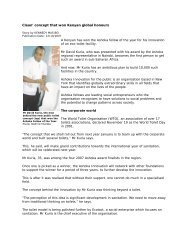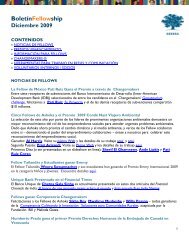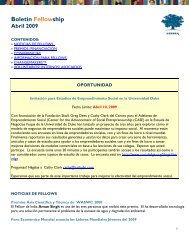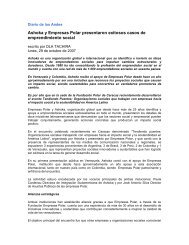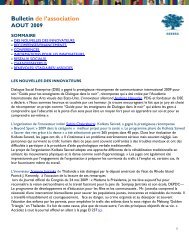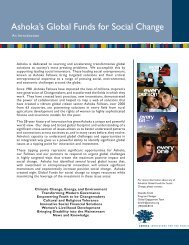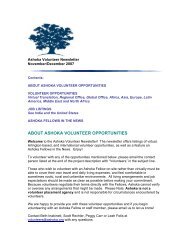Social Entrepreneurs: Doing Sustainable Development - Ashoka
Social Entrepreneurs: Doing Sustainable Development - Ashoka
Social Entrepreneurs: Doing Sustainable Development - Ashoka
You also want an ePaper? Increase the reach of your titles
YUMPU automatically turns print PDFs into web optimized ePapers that Google loves.
<strong>Social</strong> <strong>Entrepreneurs</strong>: <strong>Doing</strong><br />
<strong>Sustainable</strong> <strong>Development</strong><br />
The <strong>Ashoka</strong> Green Paper for the WSSD
A<br />
shoka: Innovators for the Public is an Arlington VA-based international development organization with a mission<br />
to advance social entrepreneurs. Founded in 1980, <strong>Ashoka</strong> has invested in and supported over 1,200<br />
social entrepreneurs in 43 countries. <strong>Ashoka</strong>'s Environmental Innovations Initiative works to distill the insights<br />
and best practices of the more than 300 social entrepreneurs <strong>Ashoka</strong> has elected working on environmental<br />
issues and to feed this knowledge back to environmental practitioners globally.<br />
Since January of 2002, 47 <strong>Ashoka</strong> Fellows from 24 countries have been engaged in an on-line discussion on<br />
issues related to this August's World Summit on <strong>Sustainable</strong> <strong>Development</strong>. This discussion has included six<br />
working groups on water, farms, energy, cities, people and the environment and partnerships across sectors.<br />
This paper is intended to introduce those interested in sustainable development to social entrepreneurs and to<br />
share some of the insights of this on-line conversation. See the Appendix for a list of contributors to this paper.<br />
Top: Gambian Fellow<br />
Yusupha Kujabi; Middle:<br />
Medicinal and edible plants<br />
at Fellow Paul Cohen’s<br />
Tlholego ecovillage, South<br />
Africa; Bottom: Fitzroy<br />
Range, Patagonia, Chile<br />
Prologue<br />
We, children of the earth, recognize the perfection of life that is housed in biodiversity,<br />
sustaining the tapestry of life. We are a collective mind creating new paradigms<br />
that open doors to reconciliation with the earth and each other. We are the tools that<br />
crystallize creativity, love, joy and, above all, a great passion to apply common sense<br />
solutions.<br />
<strong>Ashoka</strong> Fellows, Tlholego Ecovillage, South Africa<br />
A note from the artist<br />
Rhetoric without action is pointless. The cut up words, which make up the outskirts of<br />
the cover, represent the current trend in sustainable development. Moving inwards,<br />
through the circle of stylized people, the image begins to move away from rhetoric<br />
toward a state of action. Thus the circle of people symbolizes both <strong>Ashoka</strong> as an institution<br />
and the communities with which <strong>Ashoka</strong> is associated. This movement from<br />
rhetoric to action is also visually depicted by the tree, which forms the focus of the<br />
image.<br />
Jason Theron
Quick and dirty summary<br />
The legacy of the 1992 Rio Conference on Environment and <strong>Development</strong><br />
has been mixed: strong on PR and institutional development, but weak on<br />
results. Thus, moving forward from the WSSD in Jo'burg, the emphasis must<br />
be on implementation and results. <strong>Social</strong> entrepreneurs, including those<br />
elected as <strong>Ashoka</strong> Fellows, have already had significant experience transforming<br />
sustainable development from an engaging concept into a reality onthe-ground.<br />
This paper shares several narratives of the work of <strong>Ashoka</strong>'s<br />
social entrepreneurs on sustainable development along with some of their<br />
common characteristics and challenges.<br />
The key characteristics that differentiate <strong>Ashoka</strong>'s best social entrepreneurs<br />
working on sustainable development from the rest are seemingly opposed at<br />
first glance. Much of the success of leading social entrepreneurs stems from<br />
the ability to balance and exploit these forces.<br />
Dispassionate analyzes drive passionate bets. Leading social entrepreneurs<br />
have the ability to evaluate the system dispassionately and the vision to<br />
make a passionate bet on a strategy to change the system.<br />
The community is the compass, but a compass without a map is pretty useless.<br />
Community needs and preferences must fundamentally drive social<br />
entrepreneurial efforts. But these efforts must also be pragmatic and opportunistic<br />
about external realities.<br />
Capacitate citizens to take charge. A key to long-term sustainability is community<br />
control over natural resources.<br />
Adaptive discipline. Leading social entrepreneurs are focused, disciplined,<br />
and unrelenting, yet simultaneously adaptive to changing circumstances and<br />
new information.<br />
Equity needs ecology and ecology needs equity. <strong>Ashoka</strong> Fellows working on<br />
sustainable development recognize the fundamentally interconnected relationship<br />
between ecology and equity-one cannot flourish without the other.<br />
Integrating these insights more fully into the work of social entrepreneurs will<br />
result in incremental progress. But there are nevertheless tremendous challenges<br />
<strong>Ashoka</strong> Fellows face that dampen their effectiveness. It is here where<br />
the stakeholders in Jo'burg can best support social entrepreneurs.
page two<br />
Top: Jumping rope at an<br />
after-school program in<br />
South Africa; Middle:<br />
Waste collectors in<br />
Mumbai; Bottom: Fair<br />
Trade products, a niche<br />
market for many <strong>Ashoka</strong><br />
Fellows<br />
More investment or fuel will incubate and grow social entrepreneurial innovations.<br />
Policy changes that internalize external costs and benefits will buttress<br />
existing social entrepreneurial efforts and unearth new opportunities<br />
for social entrepreneurs to exploit. Better information and the capacity to<br />
use this data intelligently will allow social entrepreneurs to make smarter<br />
decisions. Similarly, better cooperation and coordination both among social<br />
entrepreneurs and across sectors will improve impact at a low cost. Finally,<br />
increased visibility will encourage new entrants that will, in turn, lead to more<br />
and more effective social entrepreneurial efforts globally.<br />
Rio: its successes and its discontents<br />
Amid much fanfare, the 1992 Conference on Environment and <strong>Development</strong><br />
in Rio boosted the environment's profile and elevated the term "sustainable<br />
development" into common parlance. Since then, Rio's immediate legacy<br />
has been strong on PR and institutional development, but weak on results.<br />
Inspect the deliverables from Rio and the reality on the ground. Though the<br />
Convention on Biological Diversity represents a significant step forward in<br />
rhetoric, rates of extinction remain at 100 to 1,000 times the natural background<br />
rate while community rights to these biological resources remain at<br />
issue. Similarly with climate change, despite the tremendous expenditure of<br />
diplomatic effort on the Kyoto Protocol, global emissions of carbon dioxide<br />
increased by more than 9% over the last decade and the Protocol itself has<br />
been left to flounder, handicapped by the non-participation of the world's<br />
most prolific polluter.<br />
The development dimension looks similarly bleak. Even with recent<br />
improvements, approximately 1.3 billion people, one quarter of the world's<br />
population, still live on under $1 a day, and 14% of the world's children still<br />
do not receive a primary education.<br />
The hope is that Jo'burg will focus on implementation and that its legacy will<br />
actually be sustainable development-as opposed to merely image and institutional<br />
development-measured in terms of increased equity and a cleaner<br />
environment.<br />
Now we need results -- so how do we get there?<br />
The fashionable strategies to move forward on sustainable development<br />
emerging before Jo'burg include mechanisms to ensure corporate accountability,<br />
increased overseas development aid, and partnerships among businesses,<br />
governments, and NGOs. Certainly these tacks are promising and<br />
worth pushing forward, but there is an essential and often overlooked set of<br />
actors with unique skills and dispositions that is key to the success of any of<br />
these strategies-actors who will produce results whether working in a relatively<br />
enabling or disabling environment.<br />
Much of the phenomenal growth in economic activity over the past 300 years<br />
can be linked to a personality type, the entrepreneur, innovating, adapting,
and, of course, relentlessly pursuing his or her vision of a better good or service.<br />
Imagine if this power was redirected for the common good? At <strong>Ashoka</strong>,<br />
we call these individuals social entrepreneurs. People, who like their counterparts<br />
in the business world, use their creativity, pragmatism, dogged commitment,<br />
and vision to tackle the full gamut of the world's social and environmental<br />
challenges.<br />
Since it's founding in 1980, <strong>Ashoka</strong> has elected over 1200 leading social<br />
entrepreneurs as "Fellows" in 43 countries, 300 of whom work on sustainable<br />
development in its strictest sense-finding development paths that sustain<br />
and restore ecological and human systems. All 1,200+ of our Fellows<br />
work on building a more robust and effective civil society, an integral dimension<br />
of sustainable development, by tackling issues ranging from disability<br />
rights and health care to early childhood education and small business development.<br />
This paper is intended to share with you several narratives about the work of<br />
social entrepreneurs on sustainable development along with some of their<br />
successes, insights, and challenges. The hope is that this paper will give you<br />
a sense of the potential of these individuals to transform sustainable development<br />
from an engaging concept into a reality in communities around the<br />
world.<br />
<strong>Social</strong> entrepreneurs short circuit the system<br />
You find yourself in Delhi, amid the whiz of three-wheeled taxis and the blackened<br />
remnants of more than one by-gone empire. <strong>Ashoka</strong> Fellow Ravi<br />
Agarwal approaches. He could pass as an up-and-coming Indian businessman<br />
from a technology center like Bangalore or Palo Alto. Dressed in the<br />
international uniform of the post-industrial professional,<br />
business casual, and holding a sleek new Nokia mobile, you<br />
meet him as he navigates his way to work through the traffic<br />
snarls and particulate hotspots of the bustling metropolis.<br />
Probe a little deeper and the snap impression holds: an<br />
engineering degree and an MBA from one of India's top universities,<br />
a professional history as a corporate executive and<br />
a successful business entrepreneur.<br />
Together you arrive at his start-up, and the dissonance<br />
starts to kick in. Instead of building a better optical switch<br />
or consulting on supply chain management, ToxicsLink is short-circuiting the<br />
system in India that creates toxic pollution and disproportionately burdens<br />
the poor with its health impacts. "Everyone in India contributes to the generation<br />
of toxins like industrial pollution and medical waste," says Ravi.<br />
"Unfortunately, the burdens of living and working around these environmental<br />
hazards fall disproportionately on the poorest and lowest caste communities.<br />
These are the people least likely to have the ears of government officials<br />
or the information to recognize and minimize these dangers. This<br />
Catch-22 gets worse as often these communities are dependent upon<br />
income from scavenging through hazardous garbage to afford the most basic<br />
necessities."<br />
Recognizing the lack of adequate regulation, enforcement mechanisms, rep-<br />
Ravi Agarwal<br />
page three
page four<br />
Jadwiga Lopata<br />
utable information, co-ordination among environmental NGOs, and organization<br />
of affected communities, ToxicsLink has positioned itself in the center of<br />
this box. ToxicsLink starts with ensuring that data is reliable and irrefutable<br />
with professional monitoring and analysis. From this base, the various constituencies<br />
are engaged. It shares this information with the most at-risk communities,<br />
so that they can organize and develop preferences about how best<br />
to address the problem. It feeds this knowledge into a network, initiated by<br />
ToxicsLink, of over 350 NGOs so the public interest community can select the<br />
most leveraged opportunities for protection and deploy its efforts most efficiently<br />
and effectively. Finally it uses this data as the basis for its advocacy<br />
efforts with the government and businesses.<br />
Still early on, ToxicsLink is beginning to get traction. An integrated community-based<br />
waste management system using the ToxicsLink model has been<br />
replicated across 8 of India's most populous cities. Ravi and ToxicsLink have<br />
also been instrumental in the development of landmark policies including a<br />
1998 law regulating medical waste and a 2000 statute governing all waste<br />
management activities. "The most at-risk communities are beginning to<br />
understand how to protect themselves while making a living," says Ravi. "It<br />
is still taking its first steps, but the system is turning and the playing field is<br />
becoming more fair."<br />
Resurrecting the family farm<br />
Fly half way around the world, to Kracow, Poland. Rent a car<br />
and drive 80 kilometers into the countryside. Around you<br />
are family farms, the kind of farms that hark back to Grant<br />
Wood paintings, not the colossal agribusiness and collective<br />
operations that have spread from the Central Valley of<br />
California to the rice fields of Indonesia thanks to the Green<br />
Revolution.<br />
Livestock mill about, farmhouses face the country road<br />
proudly, stout-looking farmers tend to their crops. It is a<br />
lifestyle that is slowly disappearing throughout the world, as the process of<br />
feeding the world has become more mechanized, pesticide-reliant, and capital-intensive.<br />
Bucking this trend, these family farms in southern Poland are<br />
thriving.<br />
At the center of this backlash is growing demand for organic produce and<br />
dairy goods, a former software engineer and current <strong>Ashoka</strong> Fellow named<br />
Jadwiga Lopata, and a simple but ingenious new set of farm products. Like<br />
many disaffected urbanites, Jadwiga was drawn to rural Poland by the lure of<br />
a simpler and healthier lifestyle made possible by the small-to-medium scale<br />
family farm. Unfortunately, the viability of the Polish family farm was, as it<br />
still is in most of the world, threatened by roll-ups into larger farms that deliver<br />
economies of scale at some cost to society: pesticides polluting air and<br />
water, monoculture replacing a more diverse variety of crops, and the underlying<br />
unit of the family farm getting squeezed from all sides.<br />
Despite growing demand for organic products, many family farmers cannot<br />
afford the transition costs of "going organic"-the cost of certification itself and<br />
3 years of reduced earnings, the usual waiting period before products can be<br />
marketed as such for premium prices. Furthermore, some farmers cannot
justify the switch based upon the risk that growth projections for organic<br />
products will prove less optimistic. Recognizing these hurdles and the aesthetic<br />
appeal of the family farm, Jadwiga started pushing agro-tourism.<br />
She formed an organization called ECEAT-Poland to accredit and catalogue<br />
organic (and soon-to-be organic) family farms and to market this network of<br />
farms to leverage points in the tourism industry. Today, there are over 130<br />
organic farms in the network collectively hosting over 5,000 agro-tourists per<br />
year. The supplemental income from tourism, roughly 20% of typical farm<br />
revenues, allows farmers to cover some of the transition costs to organic<br />
and, over the longer run, to hedge against fluctuations in the organic food<br />
market. With <strong>Ashoka</strong> support, this agro-tourism model has gained beachheads<br />
in South America and elsewhere in Europe.<br />
Ironically, the success of ECEAT's work has taken Jadwiga away from the simpler<br />
life she was trying to carve out for herself in the first place. Flying to<br />
London one week to promote agro-tourism to key actors like tour operators,<br />
travel writers, and travel agents and to San Francisco the next to collect a<br />
prestigious award like the Goldman Prize can extract a toll on the psyche.<br />
But Jadwiga, dressed as always in her oddly fashionable Polish peasant<br />
frock, rolls with it, "The airplane food is horrendous, but once I started packaging<br />
my own delicious and nutritious snacks, I was able to gain some perspective<br />
on the sacrifice."<br />
When buffalo get in the way of conservation perfection<br />
Take another set of flights. Across the Atlantic and south to Sao Paulo, a<br />
sprawling megacity in the heart of the Atlantic Forest of Brazil. The Mata<br />
Atlantica is one of the most biodiverse regions in the world-home to wildlife<br />
ranging from the roseate spoonbill (if flamingos and cranes could reproduce<br />
together) to the pygmy tiger like margays, and also to over 65 million<br />
Brazilians. Being some of the most easily accessible lands to early European<br />
settlers and rich in natural resources, the Atlantic Forest has been reduced<br />
to 7% of its former range. Some people, however, are starting to push that<br />
percentage back up in a way that captures the essence of sustainable development.<br />
Clovis Borges and Fabio Rosa, both <strong>Ashoka</strong> Fellows, both working on sustainable<br />
development, could not be more dissimilar in many ways. Clovis is<br />
tall and lanky. Fabio is short and stout. Clovis is a veterinarian turned director<br />
of one of Brazil's most prominent NGOs working on biodiversity protection,<br />
SPVS. Fabio is an engineer turned development consultant who has spent<br />
most of his professional life bringing electricity to rural communities and<br />
adapting holistic range management techniques pioneered by the likes of<br />
Allan Savory to Brazilian pasturelands.<br />
Almost two years ago, Clovis began implementing a cutting-edge carbon<br />
sequestration program in Guaraquecaba, a region of partially denuded and<br />
partially intact Atlantic Forest south of Sao Paulo in Parana State. With a 40<br />
year timeline and some $15 million from American supporters like GM and<br />
the American Electric Power Company looking to hedge their PR and Kyoto<br />
risks by locking up carbon credits, Clovis had the perfect conservation project.<br />
page five
page six<br />
Clovis Borges<br />
His plan was simple. Purchase land, protect intact areas, reforest denuded<br />
areas with native species, and then count up the carbon credits. It appeared<br />
to be a win-win-win-win-win situation: the Atlantic Forests would regain<br />
ground; communities would be fairly compensated for their land; American<br />
super-consumers would have their guilty consciences eased; an example of<br />
ecosystem services being sold would be functioning for the rest of the world<br />
to replicate; and carbon dioxide equivalent to 2.25 million cars driving for a<br />
year would be sequestered in the trees of Guaraquecaba rather than trapping<br />
heat high in the atmosphere. "It was one of the most elegant conservation<br />
programs I had ever laid eyes upon," says Clovis.<br />
Of course, plans, however perfect at first blush, rarely follow<br />
the script verbatim. Clovis soon ran up against an<br />
unforeseen brick wall. A local community grazed buffalo<br />
for milk and meat on a vital patch of land Clovis had purchased<br />
for reforestation. Despite having title in hand,<br />
Clovis and SPVS knew that simply evicting the buffalo<br />
would not ensure long-term conservation interests. This<br />
action would threaten the viability of the community by<br />
reducing a vital source of income and nutrition and precipitate a potentially<br />
disastrous public relations firefight. Through the <strong>Ashoka</strong> network, Clovis<br />
knew that the Porto Allegre-based Fabio had significant experience managing<br />
grazing animals. Perhaps Fabio could be of help.<br />
Fabio quickly surveyed the community and the rangeland in question to<br />
assess the situation. A list of community preferences and tools was compiled.<br />
Fencing could be improved, riparian areas could be better protected,<br />
particularly sensitive areas could be guarded with solar-powered electrified<br />
barriers, milking techniques could be modified, and products could be produced<br />
organically to demand higher prices at market. The best ideas were<br />
implemented with effort and resources from both the community and SPVS.<br />
In the end, a real win-win scenario emerged. The grazing land was reduced<br />
by over 20%, allowing for Clovis's conservation priorities to move forward.<br />
Simultaneously, buffalo milk production (yes there is a market for this)<br />
increased by 50% by volume and should warrant higher prices due to its now<br />
organic process. As Clovis says in retrospect, "sustainable development may<br />
sound like having one's cake and eating it too, but it can be done, successfully<br />
and smartly."<br />
What’s buzzing in Mezquitoland<br />
Your last flight sends you back across the Atlantic to Jo'burg, the site of the<br />
WSSD. After two long days of jeep rides up the coast of East Africa and into<br />
flood stricken Mozambique, you arrive in Mezimbite, a small village that<br />
<strong>Ashoka</strong> Fellow Allan Schwarz fondly calls "Mezquitoland" for its popularity with<br />
local insects. Mezimbite is at the edge of the Miombo bioregion-a 5 million<br />
square kilometer landscape sprawled across 11 southern African countries. It<br />
is home to the largest contiguous patch of deciduous tropical forests in the<br />
world and roughly 100 million people.
Stricken by civil wars and devoid of educational and economic opportunities,<br />
Mezimbite is emblematic of the world's toughest sustainable development<br />
challenges. A primary education is a luxury. The surest form of communication<br />
is a messenger. Employment, not unemployment, stands at 6%. Slash<br />
and burn agriculture and household energy needs account for more than 80%<br />
of the deforestation. And the rate of deforestation is at levels well above what<br />
one might term sustainable which, in turn, has been the dominant driver of<br />
the floods.<br />
Allan walked into this scene after a successful career as an architect that had<br />
brought him to a teaching post at the Massachusetts Institute of Technology<br />
and a lucrative partnership at an architectural firm. But something attracted<br />
him back to his native southern Africa. "Pure madness," he scoffs.<br />
In reality, the most seemingly intractable problems are not altogether hopeless<br />
when a social entrepreneur makes a bet on a strategy to turn things<br />
around. That's precisely what Allan has done in Mezimbite. Reforestation<br />
efforts have been supplemented by a cluster of forest-based value-added<br />
businesses including the manufacture of heirloom-quality furniture crafted<br />
from sustainably harvested wood. Part genius, part madness might be fair.<br />
The project began with dreaming. "I know it sounds corny," says Allan, "but to<br />
be driven you need to start with your feet firmly planted in the clouds." Yet<br />
dreams-however visual and evocative-need structure, so the next step for<br />
Allan was planning. Allan helped the community identify forests that were still<br />
intact and then formed a joint venture in the name of a local partner to secure<br />
property rights. During the next three years, Allan and the people of Mezimbite<br />
conducted an inventory of forest resources and developed a management<br />
plan that limited harvests of trees and other products to the maximum sustainable<br />
yield while continuously reforesting denuded areas.<br />
Today, following this plan, harvested trees are cut into planks by a project<br />
sawmill. A small amount of this harvest is reserved for sale at cost to local<br />
craftspeople while the rest is transported to the project's workshop, where<br />
woodworkers and apprentices trained by Allan craft furniture and other wood<br />
products. End products range from heirloom-quality armories and dinning<br />
tables sold in high-end stores in Jo'burg and London to doors and<br />
window frames purchased by the government of Mozambique for hospitals.<br />
Prior to Allan's arrival in Mezimbite in 1994, there were no reforestry<br />
initiatives in Mozambique. Today he directs 6 tree planting operations<br />
that together plant and care for roughly 25,000 trees per year.<br />
Products that have been approved for use in government hospitals are<br />
displacing imports and thus cycling more value through the local economy.<br />
The sawmills and the furniture factory employ directly and indirectly over 300<br />
people. His apprenticeship program, "basically the same one Jesus probably<br />
did 2,000 years ago" he quips, intentionally trains more apprentices than the<br />
project itself can handle to distribute these skills more widely throughout the<br />
community. Skilled workers earn incomes 12 times higher than before Allan's<br />
intervention, while the community as a whole has nudged past the poverty line<br />
on a per capita basis.<br />
"What can I say, just being able to eat regularly in this part of the world is a<br />
Allan Schwarz<br />
page seven
page eight<br />
Key characteristics<br />
of the <strong>Ashoka</strong> social<br />
entrepreneur<br />
Dispassionate<br />
analyzes drive<br />
passionate bets<br />
The community is<br />
the compass, but a<br />
compass without a<br />
map is pretty useless<br />
Capacitate citizens<br />
to take charge<br />
Adaptive discipline<br />
Equity needs<br />
ecology and ecology<br />
needs equity<br />
win," says Allan. And this success may spread far beyond the town with the<br />
swarming mosquitoes. Through Allan's influence, the Provincial Governor has<br />
banned the export of raw logs until better monitoring systems are in place.<br />
What is driving the social entrepreneur?<br />
The basic model of the social entrepreneur working in sustainable development<br />
is fairly simple. Assess a problem, understand the environmental,<br />
social, and economic dimensions. Figure out the leverage points, then execute<br />
like a pit bull being told to eat every T-bone steak in a butcher's shop,<br />
that is relentlessly and efficiently. Not quite as easy as it sounds, but not<br />
rocket science either.<br />
This having been said, there are some at first contradictory characteristics<br />
that crosscut leading social entrepreneurial efforts in sustainable development<br />
that appear to be distinctive traits. Part of what differentiates the<br />
social entrepreneurial project from your garden-variety sustainable development<br />
effort is the ability to balance and harness a set of these potentially<br />
opposed notions to drive better and better results.<br />
Dispassionate analyzes drive passionate bets<br />
Leading social entrepreneurs have the ability to evaluate the system dispassionately,<br />
but then have the vision to make a passionate bet on a leverage<br />
point and a strategy to tip that leverage point. Allan's project frontloads<br />
tremendous energy into mapping the ecosystem and identifying what the<br />
maximum sustainable yield will be before venturing into the harvesting and<br />
manufacturing stages-all this while keeping his boots firmly planted in the<br />
clouds.<br />
The community is the compass, but a compass without a map is pretty useless<br />
Community needs and preferences must fundamentally drive social entrepreneurial<br />
efforts. But these efforts must also be pragmatic and opportunistic<br />
about external realities. A classic example is Jadwiga, driven by the<br />
desire to preserve the institution of the traditional Polish family farm, yet<br />
quick to capitalize on an emerging taste among urban professionals for<br />
alternative forms of tourism.<br />
Capacitate citizens to take charge<br />
A key to long-term sustainability is community control over natural resources.<br />
However, a reality faced by many communities is that traditional control and<br />
decision making systems may need to be revived or may be strained when<br />
encountering previously non-existent threats. Therefore intervention is<br />
sometimes necessary. But the intervention, to be lasting, must be aimed at<br />
capacitating local control as opposed to simply solving the problem at hand.<br />
ToxicsLink puts not only data in the hands of communities impacted by toxic<br />
pollution, but also the knowledge and ability to continue monitoring, to<br />
assess the resulting data, and to identify the most promising strategies to<br />
address future problems.<br />
Adaptive discipline<br />
The protagonists you have met are focused, disciplined, and unrelenting, yet<br />
simultaneously adaptive to changing circumstances and new information. It<br />
is a unique temperament that allows one to be single minded without being<br />
narrow minded. Clovis, in his decision to engage Fabio with his buffalo chal-
lenge, embodies this ability to be fixated on conservation yet ready to switch<br />
gears and bring in a community development expert when faced with an<br />
unforeseen challenge without losing sight of the original conservation goals.<br />
Equity needs ecology and ecology needs equity<br />
Ravi, Jadwiga, Clovis, Fabio, and Allan all implicitly recognize the transitive<br />
and fundamentally interconnected relationship between ecology and equityone<br />
cannot flourish without the other and development cannot truly be sustainable<br />
unless these twin pillars are structurally sound. Equity includes<br />
race, class, nationality, and gender. Ecology includes everything. As the<br />
Heinrich Boll Foundation pithily articulated in its Jo'burg Memo "there cannot<br />
be ecology without equity and there cannot be equity without ecology." The<br />
work of Allan Schwartz in Mozambique perhaps best illustrates this phenomenon.<br />
The conservation gains from reforestation will not be lasting without<br />
local industries that provide economic incentives to move away from slash<br />
and burn agriculture and logging for household fuels; and furniture factories<br />
that squander the natural resource base will only serve to diminish future<br />
revenues and the future of the community. Incidentally, the double entendre<br />
that ecology also needs investment is intended.<br />
What do social entrepreneurs still need?<br />
Integrating these insights more fully into the work of social entrepreneurs will<br />
kick the ball toward the goal of sustainable development. Similarly, the positive<br />
feedback loop of success and attention will naturally encourage new<br />
entrants, driving more and more effective social entrepreneurial initiatives.<br />
But there are nevertheless tremendous hurdles and challenges that <strong>Ashoka</strong><br />
Fellows face that dampen the effectiveness of their efforts. It is here where<br />
the stakeholders in Jo'burg can best support this emerging class of social<br />
entrepreneurs.<br />
Investment<br />
More fuel is needed for social entrepreneurship to drive sustainable development<br />
on the ground. <strong>Ashoka</strong> provides funding for a small number of leading<br />
social entrepreneurs at an early stage, but the need is much more broad<br />
and deep than what <strong>Ashoka</strong> can satisfy. Stakeholders can and should allocate<br />
more resources (both financial and non-financial) for social entrepreneurs,<br />
as they will deliver tremendous bang for the sustainable development<br />
buck and spur innovations that may lead to exponential returns on investment.<br />
As Mexican Fellow Pati Ruiz, a former music teacher now leading a<br />
GEF-funded grassroots environmental education and sustainable development<br />
program in the Sierra Gorda, says: "The greatest idea without sustained<br />
operating resources may never have the chance to leap from a small and<br />
successful local project, to one of national or international significance."<br />
Policy environment<br />
<strong>Social</strong> entrepreneurs will see their efforts buttressed and will find more promising<br />
opportunities to exploit as the rules of the game tilt in their favor.<br />
Perverse incentives in policy and regulatory structures that encourage environmental<br />
harms and do not encourage environmental benefits must be<br />
addressed. Slovak Fellow and water management entrepreneur Michal<br />
Kravcik notes, "the right legislation can make the difference between a social<br />
entrepreneur working alone and one who is copied a thousand times over<br />
<strong>Ashoka</strong> Fellows still<br />
need<br />
Investment<br />
Improved policy<br />
environments<br />
Better information<br />
Better cooperation<br />
and coordination<br />
Increased recognition<br />
and visibility<br />
page nine
page ten<br />
Top: Indian Fellow Laxman<br />
Singh’s improved water<br />
management has brought<br />
growth to previously<br />
barren land; Middle:<br />
<strong>Ashoka</strong> Fellow Paul Cohen<br />
in Tlholego ecovillage;<br />
Bottom: Nhama Bhoomi<br />
resource center in India<br />
provides training for exchild<br />
workers<br />
because the incentives are right." At the most macro level, steps must be<br />
taken toward a global agreement on climate change with key players including<br />
the United States and China signing and ratifying such an agreement. At<br />
the national level, subsidies to environmentally harmful industries and<br />
processes must be phased out and incentives for environmentally positive<br />
innovations phased in-the costs to the environment and the benefits from<br />
environmental protection must be hardwired into policy frameworks. Finally,<br />
at the most micro level, ensuring that communities have clear rights over<br />
their natural resources is a vital starting point for the type of just and lasting<br />
change implicit in sustainable development.<br />
Better information<br />
Better environmental data and the capacity to use this data intelligently at<br />
the community level are both essential. <strong>Social</strong> entrepreneurs, like business<br />
entrepreneurs, need the best information to make smart strategic and operational<br />
choices. Often <strong>Ashoka</strong>'s leading social entrepreneurs, like Ravi, are<br />
working directly on these issues. More often, however, the technological and<br />
capital hurdles are too high for grassroots social entrepreneurs to clear. Anil<br />
Singh, an Indian Fellow and a veteran of many community development projects,<br />
says: "access to information creates decision making power, a fundamental<br />
livelihood right." Commitments from governments, businesses, and<br />
NGOs to empower communities with good data and the capacity to understand<br />
this information are vital pieces of the puzzle.<br />
Better cooperation and coordination<br />
Along with better information, social entrepreneurs also need to establish<br />
better synapses with other sectors and other social entrepreneurs. Certainly,<br />
many <strong>Ashoka</strong> Fellows like Clovis and Fabio are doing this both within the<br />
Fellowship and cross sectorally, but developing greater opportunities for partnership<br />
and coordination remains low-hanging fruit. The decision makers in<br />
Jo'burg appear to have realized this and we hope that new opportunities to<br />
cooperate and coordinate our work effectively will be realized.<br />
Recognition and visibility<br />
<strong>Social</strong> entrepreneurs need recognition and visibility. For the best ideas coming<br />
from social entrepreneurs to be replicated, for the best people to enter<br />
this profession, and for the most pressing challenges in sustainable development<br />
to attract new social entrepreneurial entrants, profile for this profession<br />
and confidence in their abilities is essential. Too often, social entrepreneurs<br />
are dismissed for having wacky ideas or insufficient experience on a<br />
given issue. This is especially the case with social entrepreneurs from communities<br />
and doubly so for those working in so-called developing countries.<br />
A healthy dose of skepticism is probably a good thing, but as Zimbabwean<br />
<strong>Ashoka</strong> Fellow Esinet Mapondera says, “poverty doesn’t mean a lack of ideas<br />
or capability. In our work with the poor we often get brilliant ideas and<br />
unearth remarkable capability.”
Looking ahead<br />
<strong>Social</strong> entrepreneurs like Ravi, Jadwiga, Clovis, Fabio, and Allan are helping<br />
to develop communities in a way that protects ecological resources for<br />
future generations while ensuring that these solutions are sustainable.<br />
They will do this work by balancing and harnessing the paradoxical qualities<br />
of the leading social entrepreneur. They will do this good work regardless<br />
of whether or not the perfect enabling environment is established. They will<br />
go ahead missing key pieces, constantly adapting, and rolling with the<br />
punches.<br />
But despite the tremendous potential of these change agents, their impact<br />
will remain greatly muted without government, multilateral, business, and<br />
NGO commitments for action realized. <strong>Ashoka</strong> Fellows are the leading edge<br />
of a burgeoning class of social entrepreneurs who will play a vital, community-centered<br />
role in sustainable development. Today, they are delivering<br />
remarkable results despite the often disabling environments in which they<br />
work. It is the hope of <strong>Ashoka</strong> Fellows globally that Jo'burg's emphasis on<br />
implementation will translate into a future in which social entrepreneurship<br />
is recognized as an indispensable catalyst for sustainable development and<br />
that driving this recognition will be the information, relationships, policies,<br />
and cash to make just and lasting change happen.<br />
page eleven
appendix<br />
Contributors<br />
Ravi Agarwal, India, SRISHTI and ToxicsLink<br />
Edinéa Alcântara, Brazil, PHYSIS-Centro de Crescimento Integral<br />
Juan Carlos Antezana, Bolivia, Inti Yassi Wara<br />
Oscar Arruda, Brazil, Instituto Sertão<br />
Flick Asvat, South Africa, BUGRADO EDUTRADE<br />
Gustavo Candia, Paraguay, Eco-GLOBAL<br />
Mauricio Canedo, Bolivia, Creación<br />
Anil Chitrakar, Nepal, Environmental Camps for Conservation Awareness<br />
Paul Cohen, South Africa, Tlholego <strong>Development</strong> Project<br />
Iftekhar Enayetullah, Bangladesh, Waste Concern<br />
Victor Fodeke, Nigeria, African Environmental Action Network (EANet-Africa)<br />
Maria Elena Foronda, Peru, Instituto Ambientalista Natura<br />
Bablu Ganguly, India, The Timbaktu Collective<br />
Oswaldo Granda, Ecuador, AGFUM-Agro-forestería Urbano-Marginal<br />
Marie Haisova, Czech Republic, Gaia<br />
Jacek Jakubiec, Poland, Fundacja Kultury Ekologicznej<br />
Nancy Kgengwenyane, Botswana, Tika-Tikwe Bio Resources Trust<br />
Michal Kravcik, Slovakia, People and Water<br />
Yusupha Kujabi, Gambia, Partners for Self-Help to Self-Help<br />
Kiran Kulkarni, India, Institute for Rural Credit and Enterprise <strong>Development</strong><br />
Jadwiga Lopata, Poland, Stowarzyszenie ECEAT Polska<br />
Esinet Mapondera, Zimbabwe, Zimbabwe Women Finance Trust<br />
Mario Mejia Gutierrez, Colombia<br />
Jyoti Mhapsekar, India, Stree Mukti Sanghatana<br />
Dinesh Mishra, India, Barh Mukti Abhiyan<br />
Jacob Moatshe, South Africa, Oukasie <strong>Development</strong> Trust<br />
Beverly Moodie, South Africa, Business Outreach<br />
Osmond Mugweni, Zimbabwe<br />
Kalyan Paul, India, Pan Himalayan Grassroots <strong>Development</strong> Foundation<br />
Herlambang Perdana, Indonesia, LBH Surabaya<br />
Miklos Persayni, Hungary, Budapest Zoo<br />
Diana Pombo, Colombia, Instituto de Gestion Ambiental<br />
Pati Ruiz, Mexico, Grupo Ecológico Sierra Gorda IAP<br />
Rosa Maria Ruiz, Bolivia, Eco-Bolivia<br />
Albina Ruiz, Peru<br />
Cadudzzi Salas, Chile<br />
Jacek Schindler, Poland, Ekoidea<br />
Allan Schwarz, Mozambique<br />
Pedro Serrano, Chile, Fundacion TERRAM<br />
Sudhirendar Sharma, India, Energy Environment Group<br />
B.R Shrestha, Nepal, BMC-Silt Environmental Services Pvt. Ltd<br />
Anil Singh, India, NEED<br />
Maqsood Sinha, Bangladesh, Waste Concern<br />
Payong Srithong, Thailand, Project for Agroecology <strong>Development</strong> and Plant<br />
Genetic Resource Conservation (AGRECO/PGRC)<br />
Mark Swilling, South Africa, Spier Leadership Institute<br />
Anna Zucchetti, Peru, OACA-Oficina de Asesoria y Consultoria Ambiental<br />
To contact any of the above, please e-mail: fss@shoka.org<br />
Editing & research, Anamaria Aristizabal, Njogu Morgan, Stanley Yung<br />
Page layout & design, Thomas Cortese<br />
Photos, Janet Jarman
<strong>Ashoka</strong>: Innovators for the Public<br />
The Environmental Innovations Initiative<br />
1700 North Moore Street | Suite 2000<br />
Arlington, Virginia 22209-1929 USA<br />
T. (703) 527.8300 | F. (703) 527.8383<br />
www.<strong>Ashoka</strong>.org | info@<strong>Ashoka</strong>.org<br />
www.Changemakers.net<br />
Asunción | Bamako | Bandung | Bangkok<br />
Bogotá | Budapest | Buenos Aires<br />
Calcutta | Caracas | Dakar | Delhi | Dhaka<br />
Harare | Istanbul | Johannesburg<br />
Karachi | Kathmandu La Paz | Lagos<br />
Lima London | México City | Montevideo<br />
Ouagadougou | Prague | Quito<br />
Rio de Janeiro | San José | San Salvador<br />
Santiago | São Paulo | Vilnius | Warsaw<br />
Washington DC


